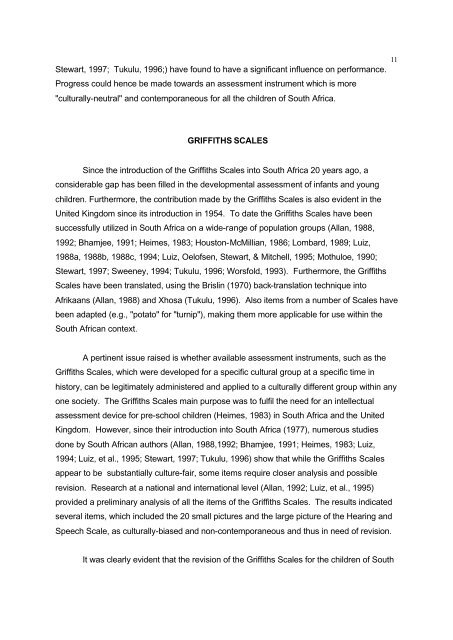nicole kotras masters thesis
nicole kotras masters thesis
nicole kotras masters thesis
You also want an ePaper? Increase the reach of your titles
YUMPU automatically turns print PDFs into web optimized ePapers that Google loves.
11<br />
Stewart, 1997; Tukulu, 1996;) have found to have a significant influence on performance.<br />
Progress could hence be made towards an assessment instrument which is more<br />
"culturally-neutral" and contemporaneous for all the children of South Africa.<br />
GRIFFITHS SCALES<br />
Since the introduction of the Griffiths Scales into South Africa 20 years ago, a<br />
considerable gap has been filled in the developmental assessment of infants and young<br />
children. Furthermore, the contribution made by the Griffiths Scales is also evident in the<br />
United Kingdom since its introduction in 1954. To date the Griffiths Scales have been<br />
successfully utilized in South Africa on a wide-range of population groups (Allan, 1988,<br />
1992; Bhamjee, 1991; Heimes, 1983; Houston-McMillian, 1986; Lombard, 1989; Luiz,<br />
1988a, 1988b, 1988c, 1994; Luiz, Oelofsen, Stewart, & Mitchell, 1995; Mothuloe, 1990;<br />
Stewart, 1997; Sweeney, 1994; Tukulu, 1996; Worsfold, 1993). Furthermore, the Griffiths<br />
Scales have been translated, using the Brislin (1970) back-translation technique into<br />
Afrikaans (Allan, 1988) and Xhosa (Tukulu, 1996). Also items from a number of Scales have<br />
been adapted (e.g., "potato" for "turnip"), making them more applicable for use within the<br />
South African context.<br />
A pertinent issue raised is whether available assessment instruments, such as the<br />
Griffiths Scales, which were developed for a specific cultural group at a specific time in<br />
history, can be legitimately administered and applied to a culturally different group within any<br />
one society. The Griffiths Scales main purpose was to fulfil the need for an intellectual<br />
assessment device for pre-school children (Heimes, 1983) in South Africa and the United<br />
Kingdom. However, since their introduction into South Africa (1977), numerous studies<br />
done by South African authors (Allan, 1988,1992; Bhamjee, 1991; Heimes, 1983; Luiz,<br />
1994; Luiz, et al., 1995; Stewart, 1997; Tukulu, 1996) show that while the Griffiths Scales<br />
appear to be substantially culture-fair, some items require closer analysis and possible<br />
revision. Research at a national and international level (Allan, 1992; Luiz, et al., 1995)<br />
provided a preliminary analysis of all the items of the Griffiths Scales. The results indicated<br />
several items, which included the 20 small pictures and the large picture of the Hearing and<br />
Speech Scale, as culturally-biased and non-contemporaneous and thus in need of revision.<br />
It was clearly evident that the revision of the Griffiths Scales for the children of South
















